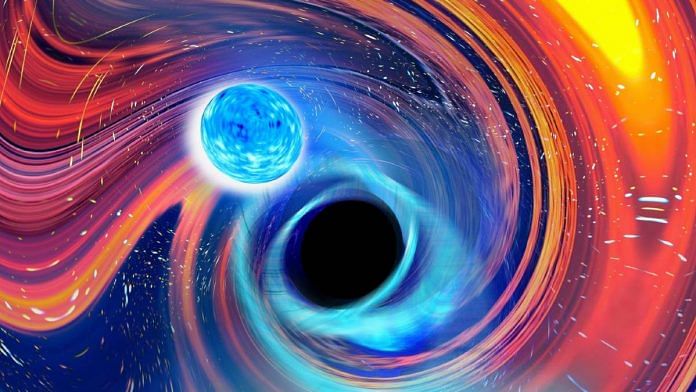New Delhi: In a first, an international team of scientists, including researchers from India, has confirmed the detection of a collision between a black hole and a neutron star, by analysing the gravitational waves created by two such events in January last year.
Gravitational waves are ripples in the space-time fabric created by extreme events, such as the collision of two blackholes or two neutron stars. While gravitational waves from several such collisions have been detected since the first discovery in 2015, they have all been a result of collision between similar cosmic bodies.
However, now the team has determined that these waves detected last January were a result of a neutron star being swallowed whole by its black hole partner.
Both black holes and neutron stars are the corpses of massive stars, with black holes being even more massive than neutron stars.
The gravitational waves (from the two black hole-neutron star collisions last January) were detected by the Laser Interferometer Gravitational-Wave Observatory (LIGO) in the United States and by the Virgo detector in Italy. The KAGRA detector in Japan, joined the LIGO-Virgo network in 2020, but was not online during these detections.
The research also involved scientists from the LIGO-India Scientific Collaboration (LISC), which includes researchers from Inter-University Centre for Astronomy and Astrophysics in Pune, Chennai Mathematical Institute, International Centre for Theoretical Sciences (TIFR) in Bengaluru, Indian Institute of Science Education and Research Kolkata, Indian Institute of Science Education and Research Pune, Institute for Plasma Research in Gandhinagar, IIT Madras, IIT Hyderabad, IIT Gandhinagar and IIT Mumbai.
The research was published in The Astrophysical Journal Letters.
The first merger, detected on 5 January, 2020, involved a black hole about nine times the mass of our sun and a neutron star about 1.9 times the mass of our sun. The second merger was detected on 15 January, and involved a 6-solar-mass black hole and a 1.5-solar-mass neutron star.
Also read: Face mask that can detect Covid in 90 mins — MIT, Harvard scientists come up with new tech
In the search of a neutron star
Astronomers have spent decades searching for neutron stars orbiting black holes in the Milky Way, the Earth’s home galaxy, but have found none so far.
“With this new discovery of neutron star-black hole mergers outside our galaxy, we have found the missing type of binary. We can finally begin to understand how many of these systems exist, how often they merge, and why we have not yet seen examples in the Milky Way,” Astrid Lamberts, a CNRS researcher at Observatoire de la Côte d’Azur, in Nice, France said in a statement.
The location of the first merger in the space remains uncertain, with the researchers estimating that it happened somewhere in an area that is 34,000 times the size of a full moon.
“While the gravitational waves alone don’t reveal the structure of the lighter object, we can infer its maximum mass. By combining this information with theoretical predictions of expected neutron star masses in such a binary system, we conclude that a neutron star is the most likely explanation,” said Bhooshan Gadre, a postdoctoral researcher at the Max Planck Institute for Gravitational Physics.
The second event, designated GW200115, was detected by both LIGO detectors and the Virgo detector. It originated from the merger of a black hole with a 1.5-solar mass neutron star that took place roughly 1 billion light-years from Earth.
Using information from all three instruments, scientists were better able to narrow down where in space this event occurred. The estimated area is almost 3,000 times the size of a full moon.
Astronomers were alerted to both events soon after they were detected in gravitational waves and subsequently searched the skies for associated flashes of light. None were found. This is not surprising due to the very large distance to these mergers, which means that any light coming from them, no matter what the wavelength, would be very dim and hard to detect with even the most powerful telescopes currently available.
Previously, the LIGO-Virgo network had found two other candidate neutron star-black hole mergers. One event called GW190814, detected on 14 August 2019, involved a collision of a 23-solar-mass black hole with an object of about 2.6 solar masses, which could be either the heaviest known neutron star or the lightest known black hole — the researchers couldn’t find anything conclusive. ThePrint had reported that this was the most asymmetrical collision ever detected.
(Edited by Poulomi Banerjee)
Also read: Venus’s clouds are too dry for life, but study findings point to Jupiter & Mars



